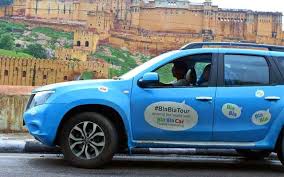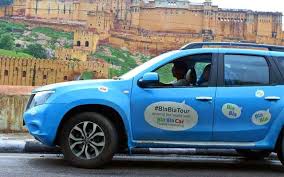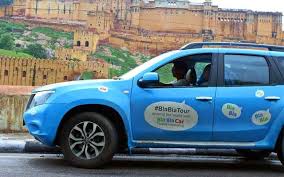Introduction
In an era where technology is reshaping every aspect of our lives, the way we travel has not been left behind. BlaBlaCar, a French-based long-distance carpooling platform, has emerged as a game-changer in the transportation industry. Founded in 2006 by Frédéric Mazzella, Francis Nappez, and Nicolas Brusson, BlaBlaCar has grown from a small startup to a global phenomenon, connecting millions of drivers and passengers across the world. This article delves into the origins, business model, benefits, challenges, and future prospects of BlaBlaCar, highlighting how it has revolutionized the way we think about travel.

The Origins of BlaBlaCar
The idea for BlaBlaCar was born out of a personal experience. Frédéric Mazzella, the founder, was trying to get home for Christmas but found that all the trains were fully booked. He noticed that many cars on the road had empty seats and wondered why there wasn’t a platform that could connect drivers with empty seats to passengers heading in the same direction. This simple yet powerful idea led to the creation of BlaBlaCar.
Initially, the platform was called “Covoiturage.fr,” which translates to “carpooling” in French. The name was later changed to BlaBlaCar, inspired by the way people describe their level of chattiness on the platform. “Bla bla” is a playful way of indicating how much someone likes to talk during a ride, with options ranging from “Bla” (not very chatty) to “BlaBlaBla” (very chatty).
How BlaBlaCar Works
BlaBlaCar operates on a simple yet effective model. Drivers who are planning a trip can list their journey on the platform, specifying the departure point, destination, date, time, and the number of available seats. Passengers looking for a ride can search for trips that match their travel plans and book a seat directly through the platform.
The platform charges a service fee to both drivers and passengers. Drivers can offset their travel costs by charging passengers a share of the fuel and toll expenses, while passengers benefit from a cost-effective alternative to traditional transportation methods like trains, buses, or planes.
BlaBlaCar also incorporates a rating and review system, allowing both drivers and passengers to rate each other after a trip. This system helps build trust within the community and ensures a safe and pleasant experience for all users.

The Benefits of BlaBlaCar
- Cost-Effective Travel: One of the most significant advantages of BlaBlaCar is its affordability. By sharing the cost of fuel and tolls, passengers can travel long distances at a fraction of the cost of traditional transportation methods. For drivers, it’s an opportunity to reduce the financial burden of long trips.
- Environmental Impact: BlaBlaCar promotes sustainable travel by maximizing the use of existing resources. By filling empty seats in cars, the platform reduces the number of vehicles on the road, leading to lower carbon emissions and a smaller environmental footprint.
- Social Connection: Unlike traditional modes of transportation, carr offers a more social experience. Passengers and drivers often engage in conversations, share stories, and even form lasting friendships. This human element adds a unique dimension to the travel experience.
- Flexibility: BlaBlaCar offers a high degree of flexibility, allowing users to choose from a wide range of trips at different times and dates. This flexibility is particularly beneficial for those who need to travel at odd hours or to destinations not well-served by public transportation.
- Safety and Trust: BlaBlaCar places a strong emphasis on safety and trust. The platform verifies user identities, offers secure payment options, and relies on a robust rating system to ensure that both drivers and passengers can travel with peace of mind.
Challenges Faced by BlaBlaCar
Despite its many benefits, it is not without its challenges. One of the primary concerns is the issue of trust and safety. While the platform has implemented several measures to ensure the safety of its users, there is always a risk when sharing a ride with strangers. Incidents of theft, harassment, or accidents, though rare, can deter potential users.
Another challenge is the regulatory environment. In some countries, carpooling is subject to strict regulations, and BlaBlaCar has faced legal hurdles in certain markets. For example, in some regions, authorities have raised concerns about whether car drivers are operating as unlicensed taxi services, which could lead to fines or restrictions.
Competition is also a significant challenge. While Car is a pioneer in the long-distance carpooling space, it faces competition from other ride-sharing platforms, as well as traditional transportation providers. To stay ahead, Car must continuously innovate and adapt to changing market dynamics.
The Future of BlaBlaCar
As BlaBlaCar continues to grow, the company is exploring new opportunities to expand its services and reach. One area of focus is international expansion. BlaBlaCar has already established a strong presence in Europe and is making inroads into emerging markets like India, Brazil, and Mexico. By tapping into these markets, BlaBlaCar can further solidify its position as a global leader in carpooling.
Another area of interest is the integration of new technologies. It is exploring the use of artificial intelligence and machine learning to enhance its platform, improve route optimization, and offer personalized recommendations to users. The company is also looking into the potential of electric and autonomous vehicles, which could further reduce the environmental impact of carpooling.
It is also considering diversifying its services. While long-distance carpooling remains its core offering, the company is exploring opportunities in other areas, such as urban carpooling, bike-sharing, and even freight transportation. By diversifying its portfolio, BlaBlaCar can create new revenue streams and cater to a broader range of transportation needs.
Conclusion
BlaBlaCar has undoubtedly revolutionized the way we travel. By leveraging technology and the power of community, the platform has created a sustainable, cost-effective, and socially enriching alternative to traditional transportation methods. While challenges remain, BlaBlaCar’s commitment to innovation and its vision for the future position it as a key player in the evolving landscape of mobility.
As we look ahead, it’s clear that is more than just a carpooling platform; it’s a movement that is reshaping the way we think about travel, community, and sustainability. Whether you’re a driver looking to offset the cost of your journey or a passenger seeking an affordable and enjoyable travel experience, BlaBlaCar offers a solution that benefits everyone. In a world where connectivity and sustainability are more important than ever, BlaBlaCar is leading the way towards a brighter, more connected future.

